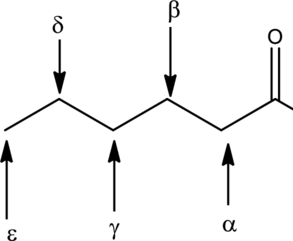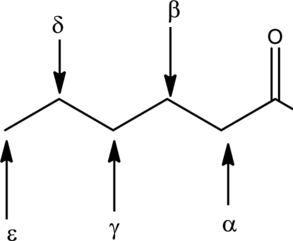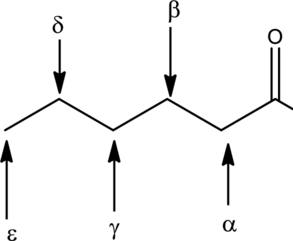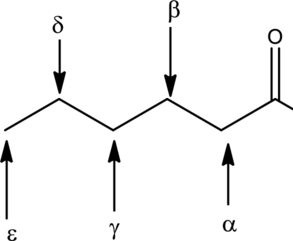
GENERAL, ORGANIC,BIO CHP.10-23-ACCESS>I
10th Edition
ISBN: 9781260506099
Author: Denniston
Publisher: MCG CUSTOM
expand_more
expand_more
format_list_bulleted
Concept explainers
Question
Chapter 14, Problem 14.38QP
(a)
Interpretation Introduction
Interpretation:
The structure for the given
Concept Introduction:
Common name of substituted carboxylic acid:
- Substituted carboxylic acids are named as derivatives of the parent compound. Common names end –ic acid rather than –oic acid.
- Greek letters are used to designate the position of the substituent.
- The atom adjacent to the carboxyl group is alpha, the next removed is beta and so on.

(b)
Interpretation Introduction
Interpretation:
The structure for the given carboxylic acid has to be drawn.
Concept Introduction:
Common name of substituted carboxylic acid:
- Substituted carboxylic acids are named as derivatives of the parent compound. Common names end –ic acid rather than –oic acid.
- Greek letters are used to designate the position of the substituent.
- The atom adjacent to the carboxyl group is alpha, the next removed is beta and so on.

(c)
Interpretation Introduction
Interpretation:
The structure for the given carboxylic acid has to be drawn.
Concept Introduction:
Common name of substituted carboxylic acid:
- Substituted carboxylic acids are named as derivatives of the parent compound. Common names end –ic acid rather than –oic acid.
- Greek letters are used to designate the position of the substituent.
- The atom adjacent to the carboxyl group is alpha, the next removed is beta and so on.

(d)
Interpretation Introduction
Interpretation:
The structure for the given carboxylic acid has to be drawn.
Concept Introduction:
Common name of substituted carboxylic acid:
- Substituted carboxylic acids are named as derivatives of the parent compound. Common names end –ic acid rather than –oic acid.
- Greek letters are used to designate the position of the substituent.
- The atom adjacent to the carboxyl group is alpha, the next removed is beta and so on.

Expert Solution & Answer
Want to see the full answer?
Check out a sample textbook solution
Students have asked these similar questions
Predict the products of this organic reaction:
0
O
-----
A
+ KOH ?
CH3-CH2-C-O-CH2-C-CH3
Specifically, in the drawing area below draw the condensed structure of the product, or products, of this reaction. (If there's more than one product, draw them
in any arrangement you like, so long as they aren't touching.)
If there aren't any products because this reaction won't happen, check the No reaction box under the drawing area.
No reaction
Click anywhere to draw the first
atom of your structure.
X
⑤
è
Predict the products of this organic reaction:
O
CH3
+ H2O + HCI A
A?
CH3-CH2-C-N-CH3
Specifically, in the drawing area below draw the condensed structure of the product, or products, of this reaction. If there's more than one product, draw them
in any arrangement you like, so long as they aren't touching.
If there aren't any products because this reaction won't happen, check the No reaction box under the drawing area.
No Reaction
Click anywhere to draw the first
atom of your structure.
What is the missing reactant in this organic reaction?
R+
HO-C-CH2-CH3
0=
CH3
CH3 —CH, C−NH—CH CH3
+ H₂O
Specifically, in the drawing area below draw the condensed structure of R.
If there is more than one reasonable answer, you can draw any one of them. If there is no reasonable answer, check the No answer box under the drawing area.
Note for advanced students: you may assume no products other than those shown above are formed.
No Answer
Click anywhere to draw the first
atom of your structure.
€
Chapter 14 Solutions
GENERAL, ORGANIC,BIO CHP.10-23-ACCESS>I
Ch. 14.1 - Assuming that each of the following pairs of...Ch. 14.1 - Assuming that each of the following pairs of...Ch. 14.1 - Prob. 14.3QCh. 14.1 - Why would you predict that a carboxylic acid would...Ch. 14.1 - Prob. 14.1PPCh. 14.1 - Prob. 14.5QCh. 14.1 - Prob. 14.6QCh. 14.1 - Prob. 14.2PPCh. 14.1 - Prob. 14.3PPCh. 14.1 - Prob. 14.4PP
Ch. 14.1 - Prob. 14.5PPCh. 14.1 - Prob. 14.6PPCh. 14.2 - Prob. 14.7PPCh. 14.2 - Prob. 14.8PPCh. 14.2 - Prob. 14.9PPCh. 14.2 - Prob. 14.7QCh. 14.2 - Prob. 14.8QCh. 14.3 - Prob. 14.10PPCh. 14.3 - Write the common and IUPAC names for each of the...Ch. 14.3 - Prob. 14.9QCh. 14.3 - Prob. 14.10QCh. 14 - Prob. 14.11QPCh. 14 - Prob. 14.12QPCh. 14 - Prob. 14.13QPCh. 14 - Prob. 14.14QPCh. 14 - Prob. 14.15QPCh. 14 - Prob. 14.16QPCh. 14 - Prob. 14.17QPCh. 14 - Which member in each of the following pairs is...Ch. 14 - Prob. 14.19QPCh. 14 - Prob. 14.20QPCh. 14 - Prob. 14.21QPCh. 14 - Prob. 14.22QPCh. 14 - Prob. 14.23QPCh. 14 - Prob. 14.24QPCh. 14 - Prob. 14.25QPCh. 14 - Prob. 14.26QPCh. 14 - Prob. 14.27QPCh. 14 - Prob. 14.28QPCh. 14 - Prob. 14.29QPCh. 14 - Prob. 14.30QPCh. 14 - Prob. 14.31QPCh. 14 - Prob. 14.32QPCh. 14 - Prob. 14.33QPCh. 14 - Prob. 14.34QPCh. 14 - Prob. 14.35QPCh. 14 - Prob. 14.36QPCh. 14 - Prob. 14.37QPCh. 14 - Prob. 14.38QPCh. 14 - Prob. 14.39QPCh. 14 - Prob. 14.40QPCh. 14 - Prob. 14.41QPCh. 14 - Prob. 14.42QPCh. 14 - Prob. 14.43QPCh. 14 - Prob. 14.44QPCh. 14 - Prob. 14.45QPCh. 14 - Prob. 14.46QPCh. 14 - Prob. 14.47QPCh. 14 - Prob. 14.48QPCh. 14 - Write an equation representing the oxidation of...Ch. 14 - Prob. 14.50QPCh. 14 - Prob. 14.51QPCh. 14 - Prob. 14.52QPCh. 14 - Prob. 14.54QPCh. 14 - Write an equation representing the neutralization...Ch. 14 - Prob. 14.56QPCh. 14 - Prob. 14.57QPCh. 14 - Prob. 14.58QPCh. 14 - Prob. 14.59QPCh. 14 - Prob. 14.60QPCh. 14 - Prob. 14.61QPCh. 14 - Prob. 14.62QPCh. 14 - Prob. 14.63QPCh. 14 - Draw condensed formulas for each of the following...Ch. 14 - Prob. 14.65QPCh. 14 - Prob. 14.66QPCh. 14 - Prob. 14.67QPCh. 14 - Prob. 14.68QPCh. 14 - Prob. 14.69QPCh. 14 - Prob. 14.70QPCh. 14 - Prob. 14.71QPCh. 14 - Prob. 14.72QPCh. 14 - Prob. 14.73QPCh. 14 - Prob. 14.74QPCh. 14 - Prob. 14.75QPCh. 14 - Prob. 14.76QPCh. 14 - Prob. 14.77QPCh. 14 - Prob. 14.78QPCh. 14 - Prob. 14.79QPCh. 14 - Prob. 14.80QPCh. 14 - Prob. 14.81QPCh. 14 - Prob. 14.82QPCh. 14 - Prob. 14.83QPCh. 14 - Prob. 14.84QPCh. 14 - Prob. 14.85QPCh. 14 - Prob. 14.86QPCh. 14 - Prob. 14.87QPCh. 14 - Prob. 14.88QPCh. 14 - Prob. 14.89QPCh. 14 - Prob. 14.90QPCh. 14 - Prob. 14.91QPCh. 14 - Prob. 14.92QPCh. 14 - Prob. 14.93QPCh. 14 - Prob. 14.94QPCh. 14 - Prob. 14.95QPCh. 14 - Prob. 14.96QPCh. 14 - Prob. 14.97QPCh. 14 - What is meant by a phosphoanhydride bond?
Ch. 14 - Prob. 14.99QPCh. 14 - Prob. 14.100QPCh. 14 - Prob. 14.101QPCh. 14 - Prob. 14.102QPCh. 14 - Prob. 14.103QPCh. 14 - Prob. 2MCPCh. 14 - Consider the Chapter Map, and explain the...Ch. 14 - Prob. 4MCPCh. 14 - Prob. 6MCPCh. 14 - Triglycerides are the major lipid storage form in...Ch. 14 - Prob. 10MCPCh. 14 - Acetyl coenzyme A (acetyl CoA) can serve as a...Ch. 14 - Prob. 12MCP
Knowledge Booster
Learn more about
Need a deep-dive on the concept behind this application? Look no further. Learn more about this topic, chemistry and related others by exploring similar questions and additional content below.Similar questions
- 个 CHEM&131 9267 - $25 - Intro to Mail - Hutchison, Allison (Student x Aktiv Learnin https://app.aktiv.com Draw the product of the reaction shown below. Ignore inorganic byproducts. + Na2Cr2O7 Acetone, H2SO4 Type here to search Dryng OH W Prarrow_forwardPredict the products of this organic reaction: OH + NaOH A? Specifically, in the drawing area below draw the skeletal ("line") structure of the product, or products, of this reaction. (If there's more than one product, draw them in any arrangement you like, so long as they aren't touching.) If there aren't any products because this reaction won't happen, check the No reaction box under the drawing area. No reaction Click and drag to start drawing a structure. ✓ Sarrow_forwardPredict the products of this organic reaction: CH3-C-O-CH2-CH2-C-CH3 + H₂O ? A Specifically, in the drawing area below draw the condensed structure of the product, or products, of this reaction. (If there's more than one product, draw them in any arrangement you like, so long as they aren't touching.) If there aren't any products because this reaction won't happen, check the No reaction box under the drawing area. No reaction Click anywhere to draw the first atom of your structure. :☐ darrow_forward
- DE d. Draw an arrow pushing mechanism for the following IN O CI N fo 人 P Polle DELL prt sc home end ins F5 F6 F7 F8 F9 F10 F11 F12arrow_forwardPredict the products of this organic reaction: + H₂O H* ? A Specifically, in the drawing area below draw the skeletal ("line") structure of the product, or products, of this reaction. (If there's more than one product, draw them in any arrangement you like, so long as they aren't touching.) If there aren't any products because this reaction won't happen, check the No reaction box under the drawing area. No Reaction Click and drag to start drawing a structure.arrow_forwardPredict the major organic products of the reaction below and draw them on right side of the arrow. If there will be no significant reaction, check the box below the drawing area instead. C Cl CH, OH There will be no significant reaction. + pyridine G Click and drag to start drawing a structure.arrow_forward
- What is the missing reactant in this organic reaction? H R+ H2O Δ OH 0= CH3-CH-O-CH3 + CH3-C-OH Specifically, in the drawing area below draw the condensed structure of R. If there is more than one reasonable answer, you can draw any one of them. If there is no reasonable answer, check the No answer box under the drawing area. No Answer Click anywhere to draw the first atom of your structure. dyarrow_forwardYou are trying to determine whether the following organic reaction can be done in a single synthesis step. If so, add any missing reagents or conditions in the drawing area below. If it isn't possible to do this reaction in a single synthesis step, check the box below the drawing area instead. Note for advanced students: if you have a choice of reagents to add, you should choose the least reactive and most economical reagents possible. Cl It isn't possible to do this reaction in a single synthesis step. + T OHarrow_forwardPredict the products of this organic reaction: CH3 O CH3-CH-C-O-CH2-CH2-CH3 + H₂OH+ Η ? A Specifically, in the drawing area below draw the condensed structure of the product, or products, of this reaction. (If there's more than one product, draw them in any arrangement you like, so long as they aren't touching.) If there aren't any products because this reaction won't happen, check the No reaction box under the drawing area. No Reaction Click anywhere to draw the first atom of your structure.arrow_forward
- € CH3-CH-C-O-CH2-CH2-CH3 + NaOH A? Specifically, in the drawing area below draw the condensed structure of the product, or products, of this reaction. (If there's more than one product, draw them in any arrangement you like, so long as they aren't touching.) If there aren't any products because this reaction won't happen, check the No reaction box under the drawing area. Predict the products of this organic reaction: CH3 O Click anywhere to draw the first atom of your structure. No reaction ✓ Garrow_forwardA molecule can have a temporary or permanent depending on the structure and the way the electrons can move. True Falsearrow_forwardedict the products of this organic reaction: CH3 O A CH3-CH-C-NH2 + H2O + HCI ? Specifically, in the drawing area below draw the condensed structure of the product, or products, of this reaction. If there's more than one product, draw them in any arrangement you like, so long as they aren't touching. If there aren't any products because this reaction won't happen, check the No reaction box under the drawing area. Click anywhere to draw the first atom of your structure. No Reaction planation Check 2025 McGraw Hill LLC. All Rights Reserved. Terms of Use | Privacy Center +arrow_forward
arrow_back_ios
SEE MORE QUESTIONS
arrow_forward_ios
Recommended textbooks for you
 ChemistryChemistryISBN:9781305957404Author:Steven S. Zumdahl, Susan A. Zumdahl, Donald J. DeCostePublisher:Cengage Learning
ChemistryChemistryISBN:9781305957404Author:Steven S. Zumdahl, Susan A. Zumdahl, Donald J. DeCostePublisher:Cengage Learning ChemistryChemistryISBN:9781259911156Author:Raymond Chang Dr., Jason Overby ProfessorPublisher:McGraw-Hill Education
ChemistryChemistryISBN:9781259911156Author:Raymond Chang Dr., Jason Overby ProfessorPublisher:McGraw-Hill Education Principles of Instrumental AnalysisChemistryISBN:9781305577213Author:Douglas A. Skoog, F. James Holler, Stanley R. CrouchPublisher:Cengage Learning
Principles of Instrumental AnalysisChemistryISBN:9781305577213Author:Douglas A. Skoog, F. James Holler, Stanley R. CrouchPublisher:Cengage Learning Organic ChemistryChemistryISBN:9780078021558Author:Janice Gorzynski Smith Dr.Publisher:McGraw-Hill Education
Organic ChemistryChemistryISBN:9780078021558Author:Janice Gorzynski Smith Dr.Publisher:McGraw-Hill Education Chemistry: Principles and ReactionsChemistryISBN:9781305079373Author:William L. Masterton, Cecile N. HurleyPublisher:Cengage Learning
Chemistry: Principles and ReactionsChemistryISBN:9781305079373Author:William L. Masterton, Cecile N. HurleyPublisher:Cengage Learning Elementary Principles of Chemical Processes, Bind...ChemistryISBN:9781118431221Author:Richard M. Felder, Ronald W. Rousseau, Lisa G. BullardPublisher:WILEY
Elementary Principles of Chemical Processes, Bind...ChemistryISBN:9781118431221Author:Richard M. Felder, Ronald W. Rousseau, Lisa G. BullardPublisher:WILEY

Chemistry
Chemistry
ISBN:9781305957404
Author:Steven S. Zumdahl, Susan A. Zumdahl, Donald J. DeCoste
Publisher:Cengage Learning

Chemistry
Chemistry
ISBN:9781259911156
Author:Raymond Chang Dr., Jason Overby Professor
Publisher:McGraw-Hill Education

Principles of Instrumental Analysis
Chemistry
ISBN:9781305577213
Author:Douglas A. Skoog, F. James Holler, Stanley R. Crouch
Publisher:Cengage Learning

Organic Chemistry
Chemistry
ISBN:9780078021558
Author:Janice Gorzynski Smith Dr.
Publisher:McGraw-Hill Education

Chemistry: Principles and Reactions
Chemistry
ISBN:9781305079373
Author:William L. Masterton, Cecile N. Hurley
Publisher:Cengage Learning

Elementary Principles of Chemical Processes, Bind...
Chemistry
ISBN:9781118431221
Author:Richard M. Felder, Ronald W. Rousseau, Lisa G. Bullard
Publisher:WILEY